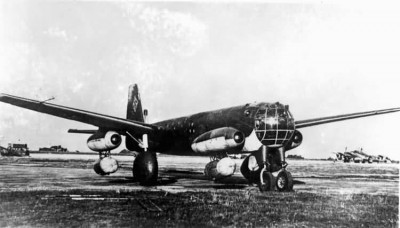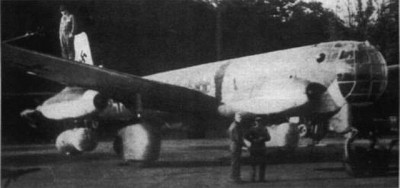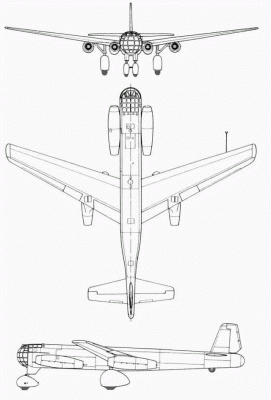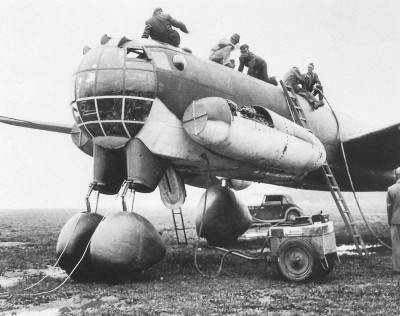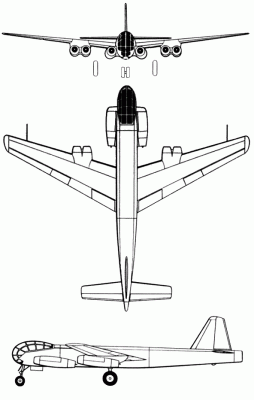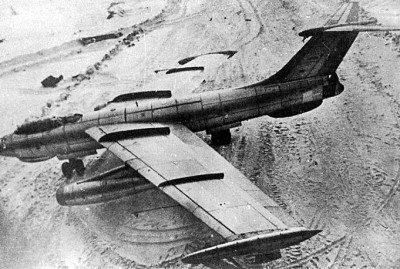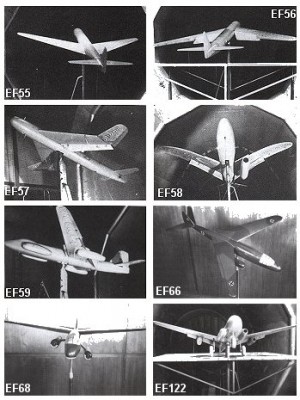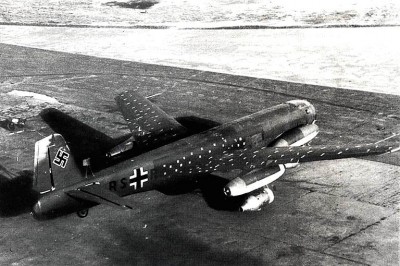| Název: Name: | Junkers Ju 287 V1 | Junkers Ju 287 V1 |
| Originální název: Original Name: | Junkers Ju 287 V1 | |
| Kategorie: Category: | experimentální letoun | experimental aeroplane |
| Výrobce: Producer: | DD.04.1944-DD.MM.1945 Junkers Flugzeug- und Motorenwerke AG, Dessau | |
| Období výroby: Production Period: | DD.04.1944-DD.MM.1945 | |
| Vyrobeno kusů: Number of Produced: | 1 | |
| První vzlet: Maiden Flight: | 16.08.1944 | |
| Osádka: Crew: | 2 | |
| Základní charakteristika: Basic Characteristics: | ||
| Vzlet a přistání: Take-off and Landing: | CTOL - konvenční vzlet a přistání | CTOL - conventional take-off and landing |
| Uspořádání křídla: Arrangement of Wing: | jednoplošník | monoplane |
| Uspořádání letounu: Aircraft Concept: | klasické | conventional |
| Podvozek: Undercarriage: | pevný | fixed |
| Přistávací zařízení: Landing Gear: | kola | wheels |
| Technické údaje: Technical Data: | ||
| Hmotnost prázdného letounu: Empty Weight: | 12510 kg | 27580 lb |
| Vzletová hmotnost: Take-off Weight: | 20000 kg | 44092 lb |
| Maximální vzletová hmotnost: Maximum Take-off Weight: | ? kg | ? lb |
| Rozpětí: Wingspan: | 20,110 m | 65ft 11,73in |
| Délka: Length: | 18,280 m | 59ft 11,69in |
| Výška: Height: | 5,100 m | 16ft 8,78in |
| Plocha křídla: Wing Area: | 58,30 m2 | 627.54 ft2 |
| Plošné zatížení: Wing Loading: | 343.053 kg/m2 | 70.26 lb/ft2 |
| Pohon: Propulsion: | ||
| Kategorie: Category: | jednoproudový | turbojet |
| Počet motorů: Number of Engines: | 4 | |
| Typ: Type: | Junkers Jumo 004 B-2 o tahu 8,73 kN (890,2 kp) | Junkers Jumo 004 B-2, thrust 1,963 lbf |
| Objem palivových nádrží: Fuel Tank Capacity: | ? | ? |
| Výkony: Performance: | ||
| Maximální rychlost: Maximum Speed: | 559 km/h v 6000 m | 347.3 mph in 19685 ft |
| Cestovní rychlost: Cruise Speed: | 512 km/h v 6809 m | 318.1 mph in 22339 ft |
| Rychlost stoupání: Climb Rate: | 7.6 m/s | 1500 ft/min |
| Čas výstupu na výšku: Time to Climb to: | 33 min do 10000 m | 33 min to 32808 ft |
| Operační dostup: Service Ceiling: | 10800 m | 35433 ft |
| Dolet: Range: | ? km | ? mi |
| Maximální dolet: Maximum Range: | 1500 km | 932.1 mi |
| Výzbroj: Armament: | - | - |
| Uživatelské státy: User States: | | |
| Poznámka: Note: | - první prototyp byl pouze experimentální, pro ověření koncepce, používal trup z He 177 A-3, ocas z Ju 388 L-1, podvozek z Ju 352 A-1 a příďová kola z B-24 - druhý prototyp měl šest motorů, podvěšených po třech pod křídly, měl nový trup odvozený od Ju 288; byl dokončen z 80 %, když padl do sovětských rukou, a byl údajně dokončen v SSSR - podle některých pramenů byl v SSSR dokončen a testován ne druhý, ale třetí prototyp, s motory BMW 003 po dvou pod křídly a dalšími dvěma na bocích přídě; protože neexistují fotografie, nelze to rozhodnout - plánovány byly ještě prototypy V4 až V6 s motory Jumo 004 C, Heinkel S 011 nebo BMW 018 | - |
| Zdroje: Sources: | Hitchcock, Thomas H. Junkers 288, Monogram Close-Up 2. Monogram Aviation Publications, Acton 1974. ISBN 0-914144-02-2. Němeček, Václav. Junkers Ju 287, L+K 1982/05. | |
| Period | - |
| Producer | - |
| Type | - |
| Camouflage | - |
| Country | - |
| Pilot | - |
| Production No. | - |
| Serial No. / Evidence No. | - |
| Tactical Marking / Imatriculation | - |
| Name | - |
| Unit | - |
| Base | - |
| Date (DD.MM.RRRR) | DD.MM.RRRR |
| Author | - |
| Print size / 300 DPI | - |
| Published with authors permit | - |
| Author Website | - |
| Period | - |
| Producer | - |
| Type | - |
| Camouflage | - |
| Country | - |
| Pilot | - |
| Production No. | - |
| Serial No. / Evidence No. | - |
| Tactical Marking / Imatriculation | - |
| Name | - |
| Unit | - |
| Base | - |
| Date (DD.MM.RRRR) | DD.MM.RRRR |
| Author | - |
| Print size / 300 DPI | - |
| Published with authors permit | - |
| Author Website | - |
| Period | - |
| Producer | - |
| Type | - |
| Camouflage | - |
| Country | - |
| Pilot | - |
| Production No. | - |
| Serial No. / Evidence No. | - |
| Tactical Marking / Imatriculation | - |
| Name | - |
| Unit | - |
| Base | - |
| Date (DD.MM.RRRR) | DD.MM.RRRR |
| Author | - |
| Print size / 300 DPI | - |
| Published with authors permit | - |
| Author Website | - |
